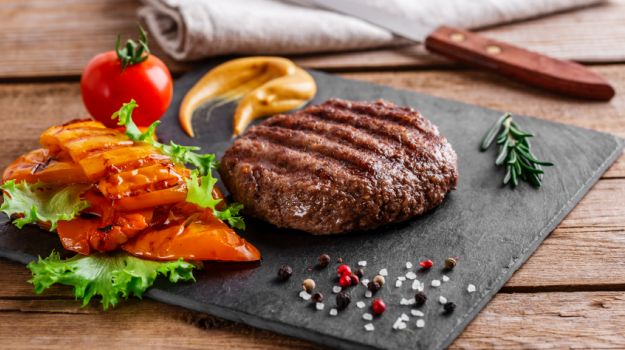Scientists and businesses working full steam to produce lab-created meat claim it will be healthier than conventional meat and more environmentally friendly. But how much can they improve on old-school pork or beef?In August 2013, a team of Dutch scientists showed off their lab-grown burger (cost: $330,000) and even provided a taste test. Two months ago, the American company Memphis Meats fried the first-ever lab meatball (cost: $18,000 per pound). Those who have tasted these items say they barely differ from the real deal.The Dutch and the Americans claim that within a few years lab-produced meats will start appearing in supermarkets and restaurants. And these are not the only teams working on cultured meat (as they prefer to call it). Another company, Modern Meadow, promises that lab-grown "steak chips" - something between a potato chip and beef jerky - will hit the stores in the near future, too.
For some people there's an ick factor to the idea of lab-grown meat, but its backers say that cultured meat may help alleviate the environmental and health challenges posed by the world's growing appetite for conventional meats. The Organization for Economic Cooperation and Development estimates that the demand for meat in North America will increase by 8 percent between 2011 and 2020, in Europe by 7 percent and in Asia by 56 percent.Meanwhile, a 2011 study calculated that growing meat in labs would cut down on the land required to produce steaks, sausages and baconby 99 percent and reduce the associated need for water by 90 percent. What's more, it found that a pound of lab-created meat would produce much less polluting greenhouse-gas emissions than is produced by cows and pigs, even poultry.Yeta 2015 life-cycle analysis of potential cultured meat production in the United States painted a less rosy picture if one includes the generation of electricity and heat required to grow the cells in a lab.
"It's really too soon to say what the environmental impacts of the first cultured meat products will be," says the lead author of that analysis, Carolyn Mattick, an environmental engineer at Arizona State University. "However, new technologies often come with trade-offs. Take automobiles, for example.They provided huge advantages over horses in the early 1900s, but all of the cars on the road today cumulatively emit a lot of carbon dioxide. That is not to say we should give up our cars or stop researching cultured meat, but rather that we should be prepared to manage the downsides."
Yet Mark Post, the Dutch scientist behind the 2013 cultured hamburger, believes the energy demands could be quite easily reduced. "One of the big energy expenditures is cleaning the tanks with heat, but simple soap might be very, very efficient," he says.The health benefits of cultured meats are still not completely clear, either. In some aspects, researchers say, lab-grown meat might be better for us. Because cultured meats would be produced in sterile environments, they would be free of such dangerous bacteria. The Centers for Disease Control and Prevention estimates that pathogens in conventional meat are the most common sources of fatal food-related infections.And the use of antibiotics in food-producing animals - to fight disease and help the animals grow faster - has been identified as a source of antibiotic-resistant bacteria that is dangerous to humans. The Food and Drug Administration estimates that the sales of antibiotics for such usage has been going up - by about 23 percent between 2009 and 2014.Both Memphis Meats and the Dutch team, which is trying to make the production of cultured beef more efficient, said they do not use antibiotics in their products because the sterile lab process does not require them. They also don't use growth-promoting hormones, which commercial feedlots give to most cattle. According to a European Commission report, their adverse effects in humans may include "developmental, neurobiological, genotoxic and carcinogenic effects." One of these hormones, estradiol, has been banned in farm animals in Europe since 2003 but is still in use in the United States.As for lab-grown meat and cancer, the story gets complicated. Last October, the International Agency for Research on Cancer, which is part of the World Health Organization, published a report that classified red meats as "probably carcinogenic to humans" and processed meats as "carcinogenic to humans." And the head of the IARC suggested that people "further support public health recommendations to limit intake of meat." Yet scientists aren't sure which elements of conventional meat are responsible for its potential carcinogenic effects."It wasn't possible to disentangle the contribution of multiple components," says Véronique Bouvard, one of the researchers responsible for the preparation of the WHO report. There are a few substances that scientists suspect, though. Among them is heme iron, which is common in meat and is found almost exclusively in meat. This form of iron can cause DNA damage and induce formation of N-nitroso compounds, some of which are potent carcinogens.A study that followed nearly 200,000 post-menopausal women found that the amount of heme iron in their diet was positively associated with an increased risk of breast cancer. Other studies show connections between heme iron intake and colon cancer.So here is the good news for lab-grown meat: According to its producers, lab-cultured beef or pork can be made completely free of heme iron. "I think that removing heme iron from meat would make for a colon-safer product," says Graham Colditz, a cancer researcher at Washington University in St. Louis who has no association with the groups producing lab meat.Another thing that might be removed from cultured meat, or significantly reduced, is saturated fat, which raises the level of bad cholesterol, increasing risk of stroke or heart disease. Healthier omega-3 fatty acids could take its place. "Stem cells are, in principle, capable of making omega-3 fatty acids. If we can tap into that machinery of the cell, then we could make healthier hamburgers," says Post, who is working on the fat content of lab-grown beef.Unfortunately, potentially carcinogenic compounds found would be harder to get rid of. Among them are nitrites and nitrates, preservatives that are commonly used in processed meats such as ham and bacon. According to Post, because cultured meats are sterile, they would require much less nitrate to stay safe to eat. On the other hand, nitrites and nitrates are also used to prevent oxidation in products such as hot dogs, so that they don't lose their appealing color. Lab-grown sausages and hams, Post says, would be "very similar to regular meat" because the compounds would still be needed to preserve the meat's appearance.Among other things that would stay in cultured meats are heterocyclic aromatic amines (HAA) and polycyclic aromatic hydrocarbons (PAHs). According to the WHO report, these chemicals can cause DNA damage. "To be honest, I wouldn't know how to affect HAA and PAHs in cultured meat," admits Post, who says he isn't even sure he would "want to change that." The reason? These substances are products of the Maillard reaction - the marriage between carbohydrates and amino acids in a slightly moist, hot environment (think grilling or roasting) that help give meat its enticing flavor."Maillard reactions are very important," says Paul Breslin, a nutritional sciences professor at Rutgers University in New Jersey. "They are the flavor of cooking and give baked cookies, fresh-baked bread and grilled ribs their characteristic flavors, which we obviously love."And that's the catch: If we remove too much fat, the meat will lose juiciness and texture. If we remove heme iron, it won't be red but yellow - the color of the beef that Post is growing in his lab. If we add too much of the omega-3 fatty acids, the meat may get a fishy flavor.Lab-grown meat may be better for the environment and improve on several health aspects of conventional meat. But for now, at least, it can't be exactly like regular meat and have no potential health downsides whatsoever."We're not there yet," acknowledges Uma Valeti, a co-founder and the chief executive officer of Memphis Meats, "but in just a few years, we expect to be selling protein-packed pork, beef and chicken that tastes identical to conventionally raised meat but that is cleaner, safer and all-around better than meat from animals grown on farms." At that point we'll be able to decide if it also tastes good.(c) 2016, The Washington Post
For some people there's an ick factor to the idea of lab-grown meat, but its backers say that cultured meat may help alleviate the environmental and health challenges posed by the world's growing appetite for conventional meats. The Organization for Economic Cooperation and Development estimates that the demand for meat in North America will increase by 8 percent between 2011 and 2020, in Europe by 7 percent and in Asia by 56 percent.Meanwhile, a 2011 study calculated that growing meat in labs would cut down on the land required to produce steaks, sausages and baconby 99 percent and reduce the associated need for water by 90 percent. What's more, it found that a pound of lab-created meat would produce much less polluting greenhouse-gas emissions than is produced by cows and pigs, even poultry.Yeta 2015 life-cycle analysis of potential cultured meat production in the United States painted a less rosy picture if one includes the generation of electricity and heat required to grow the cells in a lab.
"It's really too soon to say what the environmental impacts of the first cultured meat products will be," says the lead author of that analysis, Carolyn Mattick, an environmental engineer at Arizona State University. "However, new technologies often come with trade-offs. Take automobiles, for example.They provided huge advantages over horses in the early 1900s, but all of the cars on the road today cumulatively emit a lot of carbon dioxide. That is not to say we should give up our cars or stop researching cultured meat, but rather that we should be prepared to manage the downsides."
Yet Mark Post, the Dutch scientist behind the 2013 cultured hamburger, believes the energy demands could be quite easily reduced. "One of the big energy expenditures is cleaning the tanks with heat, but simple soap might be very, very efficient," he says.The health benefits of cultured meats are still not completely clear, either. In some aspects, researchers say, lab-grown meat might be better for us. Because cultured meats would be produced in sterile environments, they would be free of such dangerous bacteria. The Centers for Disease Control and Prevention estimates that pathogens in conventional meat are the most common sources of fatal food-related infections.And the use of antibiotics in food-producing animals - to fight disease and help the animals grow faster - has been identified as a source of antibiotic-resistant bacteria that is dangerous to humans. The Food and Drug Administration estimates that the sales of antibiotics for such usage has been going up - by about 23 percent between 2009 and 2014.Both Memphis Meats and the Dutch team, which is trying to make the production of cultured beef more efficient, said they do not use antibiotics in their products because the sterile lab process does not require them. They also don't use growth-promoting hormones, which commercial feedlots give to most cattle. According to a European Commission report, their adverse effects in humans may include "developmental, neurobiological, genotoxic and carcinogenic effects." One of these hormones, estradiol, has been banned in farm animals in Europe since 2003 but is still in use in the United States.As for lab-grown meat and cancer, the story gets complicated. Last October, the International Agency for Research on Cancer, which is part of the World Health Organization, published a report that classified red meats as "probably carcinogenic to humans" and processed meats as "carcinogenic to humans." And the head of the IARC suggested that people "further support public health recommendations to limit intake of meat." Yet scientists aren't sure which elements of conventional meat are responsible for its potential carcinogenic effects."It wasn't possible to disentangle the contribution of multiple components," says Véronique Bouvard, one of the researchers responsible for the preparation of the WHO report. There are a few substances that scientists suspect, though. Among them is heme iron, which is common in meat and is found almost exclusively in meat. This form of iron can cause DNA damage and induce formation of N-nitroso compounds, some of which are potent carcinogens.A study that followed nearly 200,000 post-menopausal women found that the amount of heme iron in their diet was positively associated with an increased risk of breast cancer. Other studies show connections between heme iron intake and colon cancer.So here is the good news for lab-grown meat: According to its producers, lab-cultured beef or pork can be made completely free of heme iron. "I think that removing heme iron from meat would make for a colon-safer product," says Graham Colditz, a cancer researcher at Washington University in St. Louis who has no association with the groups producing lab meat.Another thing that might be removed from cultured meat, or significantly reduced, is saturated fat, which raises the level of bad cholesterol, increasing risk of stroke or heart disease. Healthier omega-3 fatty acids could take its place. "Stem cells are, in principle, capable of making omega-3 fatty acids. If we can tap into that machinery of the cell, then we could make healthier hamburgers," says Post, who is working on the fat content of lab-grown beef.Unfortunately, potentially carcinogenic compounds found would be harder to get rid of. Among them are nitrites and nitrates, preservatives that are commonly used in processed meats such as ham and bacon. According to Post, because cultured meats are sterile, they would require much less nitrate to stay safe to eat. On the other hand, nitrites and nitrates are also used to prevent oxidation in products such as hot dogs, so that they don't lose their appealing color. Lab-grown sausages and hams, Post says, would be "very similar to regular meat" because the compounds would still be needed to preserve the meat's appearance.Among other things that would stay in cultured meats are heterocyclic aromatic amines (HAA) and polycyclic aromatic hydrocarbons (PAHs). According to the WHO report, these chemicals can cause DNA damage. "To be honest, I wouldn't know how to affect HAA and PAHs in cultured meat," admits Post, who says he isn't even sure he would "want to change that." The reason? These substances are products of the Maillard reaction - the marriage between carbohydrates and amino acids in a slightly moist, hot environment (think grilling or roasting) that help give meat its enticing flavor."Maillard reactions are very important," says Paul Breslin, a nutritional sciences professor at Rutgers University in New Jersey. "They are the flavor of cooking and give baked cookies, fresh-baked bread and grilled ribs their characteristic flavors, which we obviously love."And that's the catch: If we remove too much fat, the meat will lose juiciness and texture. If we remove heme iron, it won't be red but yellow - the color of the beef that Post is growing in his lab. If we add too much of the omega-3 fatty acids, the meat may get a fishy flavor.Lab-grown meat may be better for the environment and improve on several health aspects of conventional meat. But for now, at least, it can't be exactly like regular meat and have no potential health downsides whatsoever."We're not there yet," acknowledges Uma Valeti, a co-founder and the chief executive officer of Memphis Meats, "but in just a few years, we expect to be selling protein-packed pork, beef and chicken that tastes identical to conventionally raised meat but that is cleaner, safer and all-around better than meat from animals grown on farms." At that point we'll be able to decide if it also tastes good.(c) 2016, The Washington Post
Advertisement













